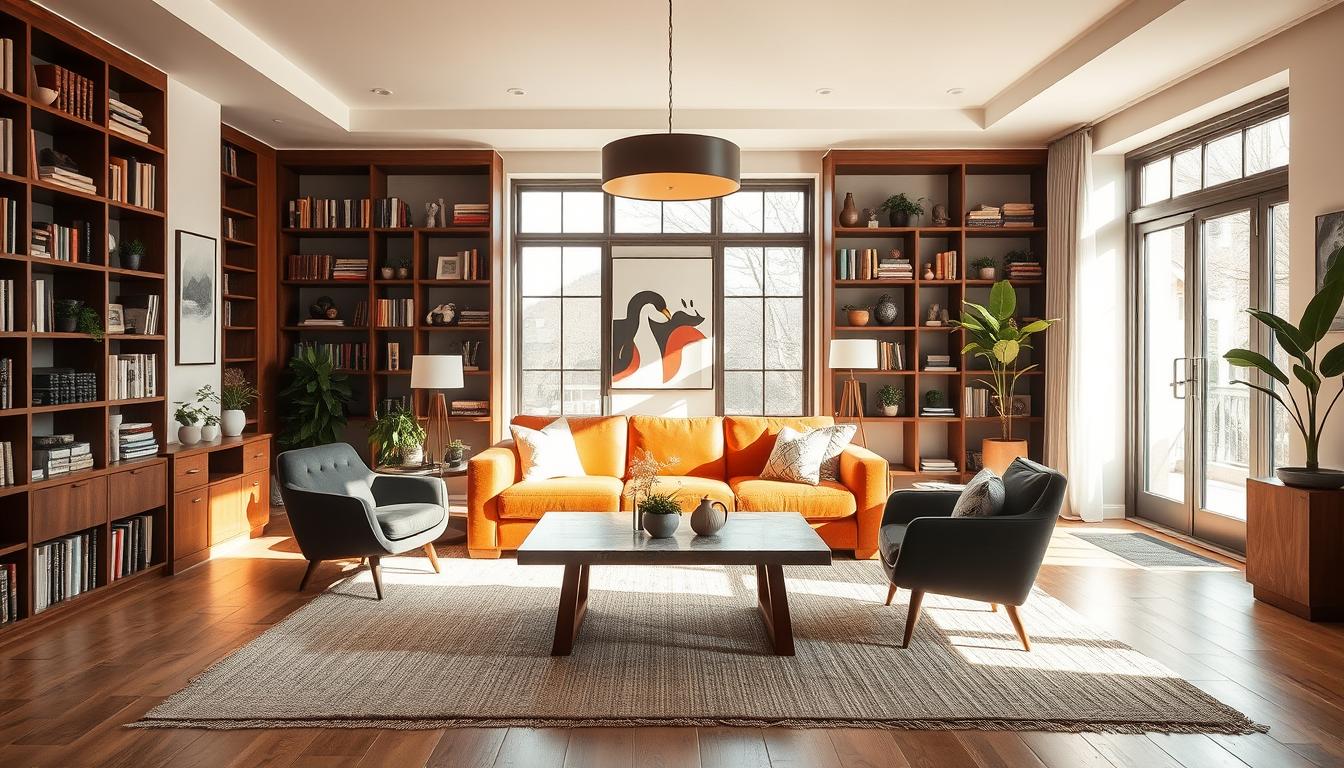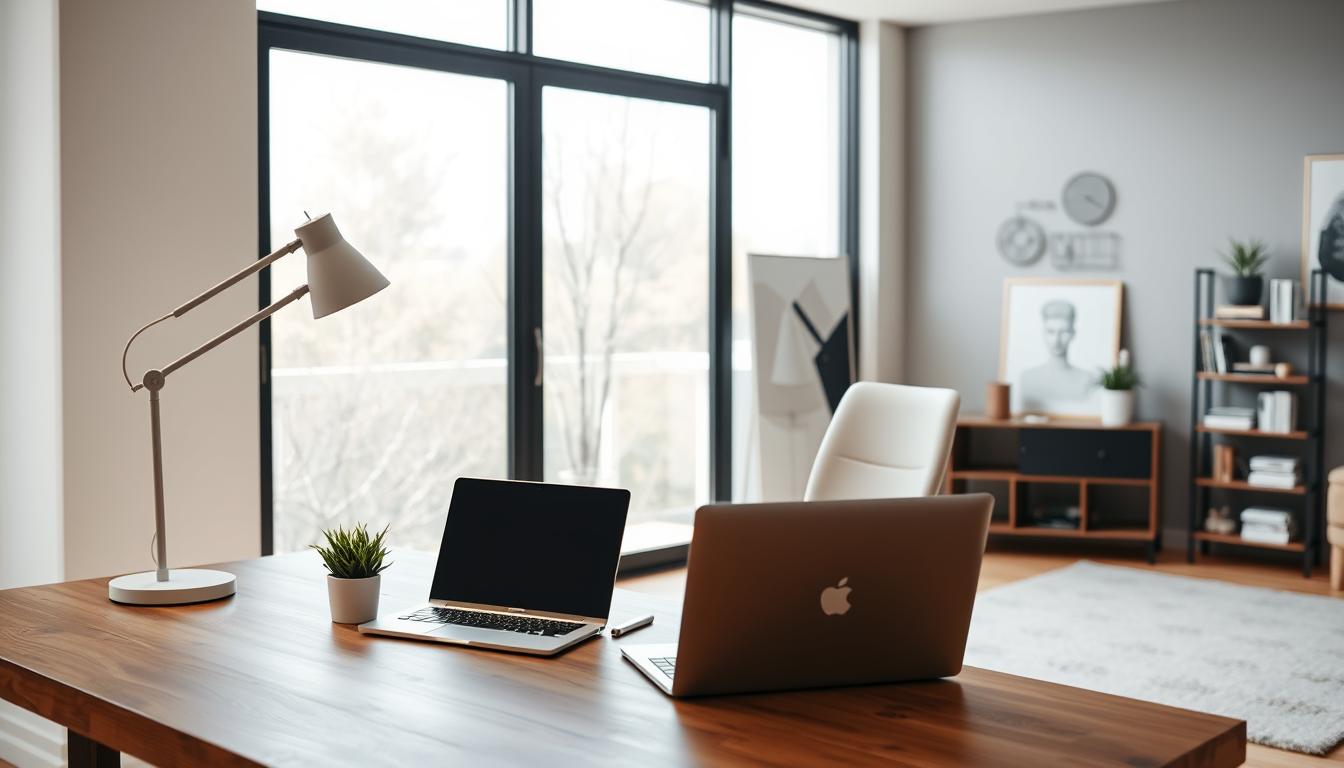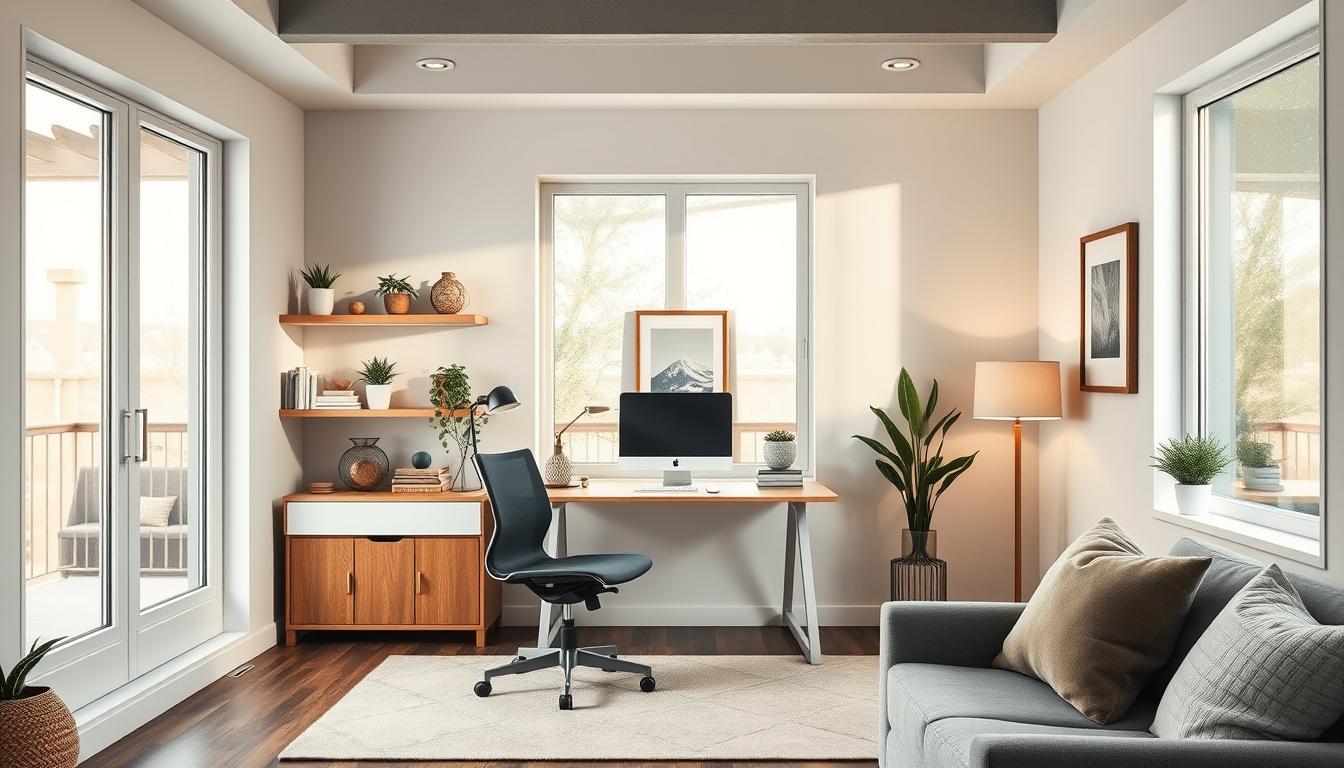Did you know a well-designed interior can boost a home’s value by up to 10%? This fact shows how crucial interior design is. It makes homes not just look good but also valuable.
Every great home décor starts with a careful plan. We’ll share our best tips for making homes interiors perfect. We’ll cover all key aspects of interior design.
Key Takeaways
- Understand the importance of interior design in enhancing your living space.
- Learn how to incorporate seasonal styles and trends into your home décor.
- Discover practical tips for creating a beautiful and functional home.
- Get insights into the latest interior design trends.
- Find out how to make your home more valuable through effective interior design.
Understanding the Importance of Interior Design
Interior design is more than just decorating. It’s about making a space that looks good and works well. We’ll explore what makes a house feel like a home.
What is Interior Design?
Interior design is the art and science of making spaces that are both beautiful and useful. It’s about creating a space that looks good and feels comfortable and safe. “Good design is obvious. Great design is transparent,” says Joe Sparano, a famous interior designer.
Interior design is not just about looks; it’s also about function. A good design should show who lives there and still be practical.
The Impact of Color
Color is key in interior design, setting the mood of a room. Different colors can make us feel different ways. For example, blues and greens calm us, while reds and oranges energize us.
Choosing the right colors is important. Colors can even help our brains work better and make us happier. We’ll look into this more later.
Functionality vs. Aesthetics
Finding a balance between function and beauty is a big challenge in interior design. A space that looks great but doesn’t work well is as bad as one that works but looks bad. The goal is to find a balance.
“The way you furnish and decorate a space can have a profound impact on your mood, productivity, and overall well-being.” –
By understanding interior design and using it wisely, we can make spaces that are not only beautiful but also improve our lives.
Choosing the Right Color Palette
Color palettes are key in interior design. They affect how a room looks and feels. Picking colors is more than just choosing hues; it’s about setting a mood.
Understanding Color Theory
Color theory helps us mix colors in a way that looks good. It’s based on the color wheel, which shows colors in a circle. The wheel has primary colors like red, yellow, and blue at the start.
The color wheel has warm and cool colors. Warm colors, like orange and red, bring energy. Cool colors, like blue and green, calm us down. Mixing these can create a balanced palette.
Popular Color Trends
Keeping up with color trends can spark our decorating ideas. Now, natural and sustainable colors are in. Shades like sage green and sandy beige are popular for their soothing feel.
Using bold, contrasting colors is also trendy. It adds depth and personality to our homes. These trends help our homes stay stylish and modern.
How to Test Colors in Your Home
It’s crucial to test the colors in our homes before deciding. We can paint small wall sections or use paint samples. Seeing how colors change with light and time helps us choose wisely.
- Consider the natural light in the room.
- Think about the color of the furniture and flooring.
- Test the colors on different walls to see how they interact.
By testing colors carefully, we can pick a palette that improves our home’s look and feel.
Furniture Selection and Arrangement
Choosing the right furniture and arranging it well is key to making a house feel like home. It’s important to find furniture that is both comfortable and stylish. This way, your space will be welcoming and useful.
Balancing Comfort and Style
Think about how each piece of furniture will be used. A sofa that looks great but is hard to sit on might not be best for a family room. On the other hand, a piece that’s comfy but not stylish can mess up the look of your room. Look for furniture that is both stylish and comfortable, like a sleek sectional sofa with soft cushions.
Tips for Small Spaces
In small rooms, how you pick and arrange furniture really matters. Choosing multifunctional furniture helps keep things tidy and makes the room feel bigger. For example, a storage ottoman can be a place to sit and also hold things like blankets or toys. Also, furniture with legs or a slim design can make a room feel more open.
- Choose furniture that serves multiple purposes.
- Opt for pieces with exposed legs to create a sense of space.
- Consider wall-mounted furniture to save floor space.
Popular Furniture Styles
Furniture styles can really change how your home looks. Right now, modern and minimalist styles are in because they are simple, clean, and useful. These styles work well in small spaces because they make rooms feel bigger and are less cluttered. But, pick a style that you like and that fits your home’s look.
By picking and arranging your furniture wisely, you can make a home that looks good, feels good, and works well. Whether you’re decorating a small apartment or a big house, the right furniture makes a big difference.
Lighting: The Unsung Hero of Home Interiors
Lighting is a key part of home interiors. It can change a room’s feel from cozy to bright. The right lighting makes a big difference.
Types of Lighting
There are many types of lighting for homes. Each has its own purpose. You have ambient, task, and accent lighting.
- Ambient lighting lights up a whole room.
- Task lighting focuses on areas for activities, like reading or cooking.
- Accent lighting highlights special features or objects.
Layering Your Lighting
Layering lighting means mixing different sources. This includes overhead lights, table lamps, and floor lamps.
This approach makes your space more interesting and useful.
Choosing the Right Fixtures
Picking the right lighting fixtures is key. The style, size, and type should match your room’s look and needs.
| Room Type | Recommended Lighting Type | Fixture Suggestions |
|---|---|---|
| Living Room | Ambient and Accent | Chandeliers, Table Lamps |
| Kitchen | Task and Ambient | Under-cabinet Lighting, Pendant Lights |
| Bedroom | Ambient and Task | Bedside Lamps, String Lights |
Knowing about different lighting types helps you plan better. This way, you can make your home look and feel great.
Incorporating Art and Decorative Pieces
The right art and decorative pieces can make a house feel like a home. They add coziness and invite you in. When done right, art brings personality and style to your space.
Selecting Art for Your Space
Finding the right art for your home can be tough. It’s key to pick pieces that speak to you and match your design. Think about the style, colors, and mood you want.
Tips for Selecting Art:
- Make sure the artwork fits your walls and furniture.
- Choose art that shows your style or interests.
- Feel free to mix different styles and mediums.
Tips for Arranging Art
Arranging art is more than just hanging pieces. It’s about telling a story with your visuals. Here are some tips to arrange your art well:
Creating a Focal Point: Use a standout piece to draw attention to a room area.
| Arrangement Style | Description | Best For |
|---|---|---|
| Gallery Style | A collection of frames hung closely together. | Large walls, living rooms. |
| Solo Piece | A single, statement artwork. | Small spaces, bedrooms. |
| Clustered | Grouping multiple pieces together. | Creating a focal point. |
Accessorizing with Decorative Items
Decorative items are the final touches that make your home unique. From vases to sculptures, they add texture and interest.
Tips for Accessorizing:
- Begin with a few standout pieces and add more.
- Mix textures and materials for depth.
- Use items to highlight your home’s features.
By carefully choosing art and decorative items, you can make your home cozy and welcoming. It will show off your personality and style.
Creating Flow and Cohesion
A beautifully designed home guides the eye smoothly, creating a sense of visual flow. This makes a home feel welcoming and stylish. Understanding how to create a cohesive look enhances your home’s aesthetic.
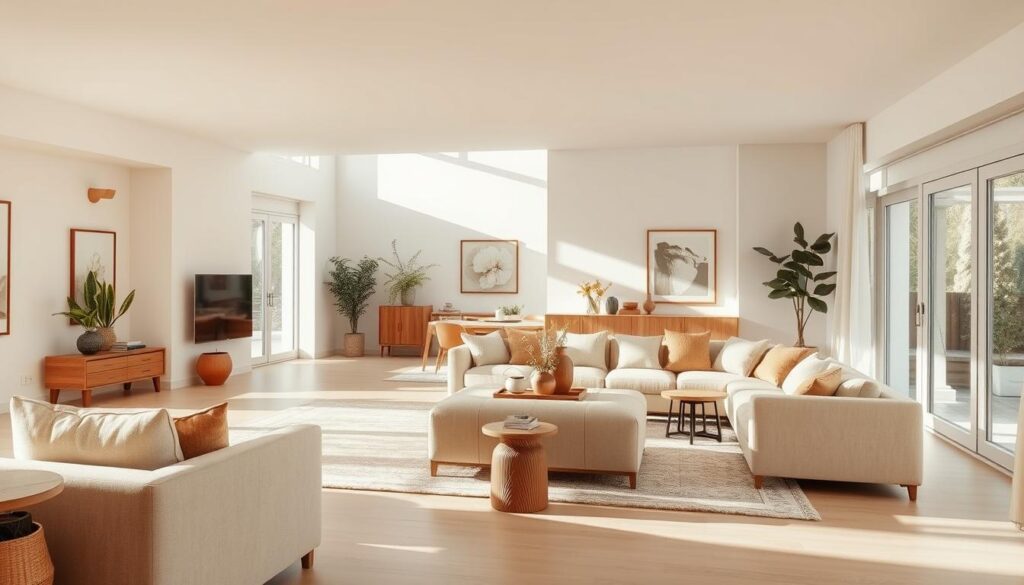
Understanding Visual Flow
Visual flow is how the eye moves through a space. It’s influenced by furniture layout, color palette, and patterns and textures. A well-placed rug can guide the eye, creating continuity.
Design your home with connections in mind. Use a consistent design element, like a color scheme or furniture style, for cohesion. For more stylish space tips, visit our page on top interior home design tips.
Tips for Consistent Design
For a consistent design, choose a core color palette and stick to it. It’s okay if each room isn’t the same color, but the colors should complement each other. Also, pick furniture with a common style or era for continuity.
- Use a consistent flooring material throughout the main areas of your home to create a sense of flow.
- Select lighting fixtures that share a common design theme to enhance cohesion.
- Consider the style and era of your furniture when making selections to ensure a cohesive look.
Using Patterns and Textures
Patterns and textures add depth and interest. Start by choosing a few core patterns and textures that work well together. For example, a geometric rug and a natural sofa texture.
Remember, balance is key when using patterns and textures. Too many can cause clutter, while too many textures can overwhelm. Striking the right balance creates a rich and inviting atmosphere.
The Role of Plants in Interior Design
Plants are now a key part of modern interior design. They add beauty and improve air quality and wellbeing in our homes. By adding plants to your decor, you can make your space look better and feel healthier.
Benefits of Indoor Plants
Indoor plants do more than look good; they clean the air and make our homes healthier. They offer many benefits, including:
- Improving air quality by removing pollutants and toxins
- Reducing stress and boosting mental wellbeing
- Enhancing the aesthetic appeal of your home
- Supporting better sleep quality
Experts say plants are essential for a healthy, sustainable home. Adding plants can greatly improve both physical and mental health.
Best Plants for Every Room
Each room in your home has its own conditions, like light and temperature. Picking the right plants for each room is key for their health and your design goals. Here are some suggestions:
- Living Room: Snake Plant, Spider Plant, or Peace Lily for low-maintenance and air-purifying benefits
- Kitchen: Basil, Mint, or Chives for a fragrant and functional addition
- Bedroom: Lavender, Snake Plant, or Jasmine for promoting better sleep
- Bathroom: Ferns, Orchids, or Bamboo Palm for humidity-loving plants
Creative Ways to Display Plants
Displaying plants in creative ways can add a special touch to your design. Here are some ideas to start with:
- Use hanging baskets to maximize space and add visual interest
- Group plants together to create a mini indoor garden
- Utilize plant stands or pedestals to elevate your plants
- Incorporate plants into your decor through terrariums or planters that match your interior style
By carefully choosing and displaying plants, you can enhance your home’s design and enjoy the benefits of indoor plants.
Personalizing Your Space
Turning a house into a home is more than just adding furniture and decor. It’s about personalizing your space to show your unique style. This means knowing what you like, staying up-to-date with design trends, and mixing them well.
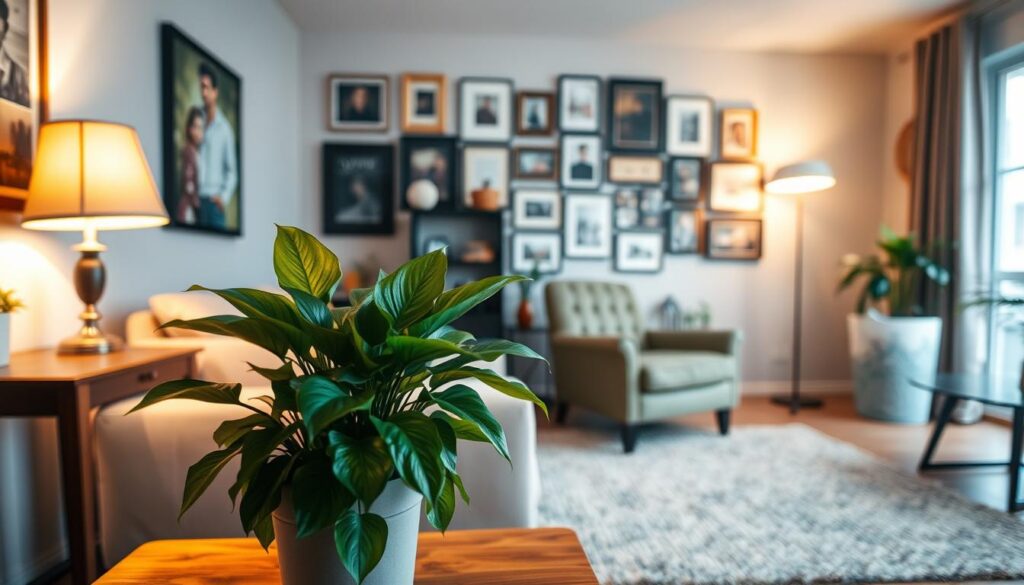
Finding Your Style
Finding your personal style is the first step in personalizing your space. It’s about knowing what you like and dislike. It also means understanding how color, texture, and furniture affect your home’s feel.
To find your style, make a mood board or collect images that inspire you. This visual guide can show you common themes and elements that match your taste.
Mixing Personal Touches with Design Trends
After finding your style, mix personal touches with the latest design trends. This mix is key to creating a space that’s both modern and personal.
- Add family heirlooms or personal items to your decor.
- Use trendy colors and patterns that fit with your furniture and decor.
- Try different textures and materials to add depth to your space.
Creating a Gallery Wall
A gallery wall is a great way to personalize your space and add interest. It lets you show off cherished memories, artwork, or meaningful items in a stylish way.
To make a gallery wall, pick a theme or color palette first. Then, choose frames that match your decor. Arrange them to create a balanced and appealing display.
Practical Storage Solutions
Storage is key to a calm living space. A tidy home looks better and works better. We’ll look at storage ideas that can change your living area.
Stylish Storage Ideas
Storage can be stylish. Luxury interior design mixes function with beauty. Think about using decorative baskets, chic shelving, or storage ottomans that match your decor.
A wooden storage chest can bring elegance to your living room. It keeps blankets and pillows neat. Under-bed storage boxes are also stylish and keep your bedroom tidy.
Multi-Functional Furniture
Multi-functional furniture is a smart choice. Items like storage beds, coffee tables with storage, and ottomans that store can cut down on mess.
Choose furniture that fits your room’s needs. A storage bed in the bedroom can hold linens and winter clothes. A storage coffee table in the living room keeps remotes and magazines organized.
Organizing Tips for Every Room
Organizing works best room by room. Here are some organizing tips to start:
- In the kitchen, use drawer dividers and spice racks for utensils and spices.
- In the bathroom, install shelves or cabinets for toiletries and towels.
- In the living room, use baskets or storage units for remotes, books, and more.
With these storage solutions and tips, you can make your home more functional and peaceful. Whether you want to boost your home’s luxury or just declutter, these strategies will help.
Sustainability in Home Interiors
Today, making our homes sustainable is key to protecting our planet. We focus on the materials we choose, how we design our spaces, and saving energy. These choices are vital for modern design.
Eco-Friendly Materials
Using eco-friendly materials is a big part of sustainable home design. These materials are made and sourced in ways that are good for the environment. Examples include reclaimed wood, bamboo, and paints with low VOCs.
It’s important to think about a material’s whole life cycle. Look for materials that last long, can be recycled, or break down naturally. For example, recycled glass for countertops or timber from sustainable forests for furniture can help a lot.
Sustainable Design Practices
Sustainable design practices aim to make spaces beautiful and eco-friendly. This means using natural light, designing spaces wisely, and choosing furniture that does more than one thing. These steps help create homes that are both stylish and green.
Following the “reduce, reuse, recycle” rule is key in sustainable design. This means cutting down on waste, using old materials again, and recycling at the end. It’s a way to think about the environmental effect of every design choice.
Energy Efficient Ideas
Making our homes energy efficient is also crucial for sustainability. We can do this by getting energy-saving appliances, better insulation, and smart home tech to watch and control energy use.
- Switching to LED lighting, which uses much less energy than old lights.
- Getting smart thermostats that learn your habits to save on heating and cooling.
- Upgrading to energy-saving windows to keep warmth in and out.
By using these energy-saving tips, we can help the planet and save money on bills. Sustainability is not just good for the environment; it’s also smart for our wallets.
Seasonal Styles and Trends
As the seasons change, our homes need a refresh to stay cozy. Embracing seasonal styles and trends keeps your space current and welcoming.
Updating Your Decor
Changing your decor with the seasons is easy. Just swap out throw pillows, blankets, and rugs. For cold months, use warm colors and textures.
In spring and summer, go for lighter colors and natural fabrics.
Seasonal Decor Inspiration
For holiday decorating, try traditional or modern themes. Use candles, garlands, and festive decor to create a cozy atmosphere. By following these trends, your home stays fresh and inviting all year.
